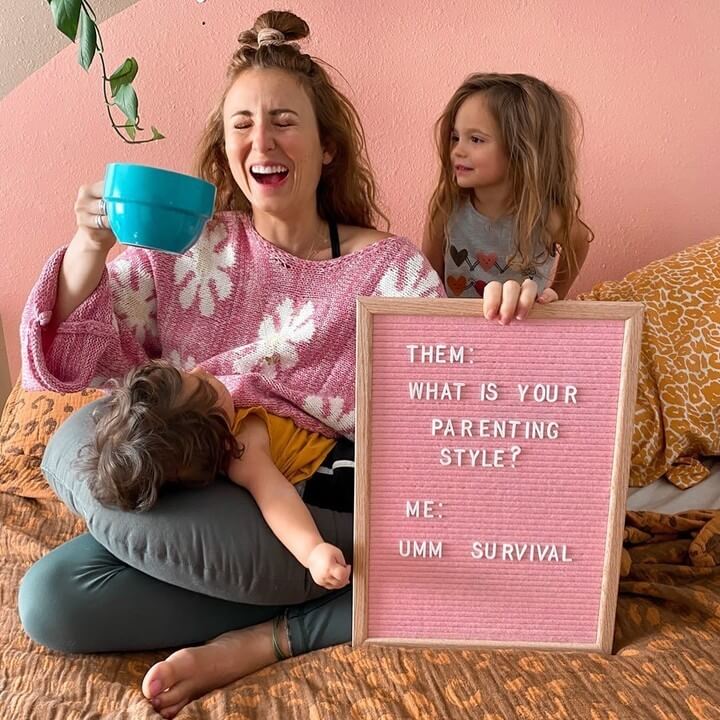Just like parenting, your feeding journey may look a lot different than someone else’s—and that’s more than okay. Breastfeeding isn’t for everyone. While it may come naturally to some moms, others may find it difficult, stressful or might just not be interested.
You may not have enough supply for your little one, your baby may not take well to breast milk or you may not want to breastfeed altogether. Wherever you land on the spectrum, if you’re interested in transitioning from breast milk to formula, it’s important to gather as much information as you can before making that big decision. That’s why we’ve interviewed Katie Clark, a Certified Lactation Educator, Certified Breastfeeding Specialist, IBCLC candidate and the brains behind The Breastfeeding Mama.
Table of Contents:
- Should Parents Switch From Breast Milk to Formula?
- Why You May Want to Make the Transition
- How Long Should You Breastfeed Before Switching?
- How to Transition From Breast Milk to Formula
- Side Effects of Transitioning
- Dealing With Judgment Around Feeding
- Why Is It So Hard Emotionally To Stop Breastfeeding?
- Doing What Works Best For You
Should Parents Switch From Breast Milk to Formula?
“I don’t recommend it as a general practice, as I do think there are many benefits to breastfeeding,” Clark says. “However, I definitely recognize and support situations where switching to formula may be the best option for a family.”
When making this big decision for you and your little one, Clark recommends looking at all of the circumstances and weighing the pros and cons. When in doubt, contact your pediatrician to get their breastfeeding advice.
What About Mixed Feeding?
Clarke says that mixed feeding can be a great option for those who want to still provide breast milk, but may not be able to provide the amount their child needs. It’s important to always go about this carefully though, she says.
Why You May Want to Transition From Breast Milk to Formula

Clark mentioned that there are a few main reasons why parents may want to switch from breast milk to formula.
- Severe food intolerances with the baby that the mother is unable to completely remove from diet
- Low supply and pumping are too overwhelming for mom to continue
- Breastfeeding is impacting mental health
- Baby is not gaining well on breast milk and interventions have not helped
- They just don’t want to breastfeed anymore
How Long Should You Breastfeed Before Switching to Formula?
The American Academy of Pediatrics (AAP) recommends exclusive breastfeeding for the first six months. However, Clark says that you can introduce formula at any age. “If a child is breastfeeding well, there’s no need to introduce formula at any point. If you know you want to offer formula, it’s probably better to do it sooner rather than later,” she says.
How to Transition From Breast Milk to Formula
If you’re going to make the switch, here are Clark’s top tips for introducing formula to a breastfed baby:
- Avoid going cold turkey—this could be upsetting to your baby’s stomach
- Start with a ¾ breast milk bottle, ¼ formula and slowly switch the proportions
- Make sure you transition your body as well. Even if you’re ready to be done breastfeeding or have to stop for various reasons, your body might need more time to adjust
- If your child transitions easily, you may need to use hand expression or a breast pump to wean back
- You can use tools like peppermint/sage tea, cabbage leaves or even decongestants to help dry up your supply
Clark says it can take anywhere from a few days to a month for your baby to adjust from breast milk to formula.
What if Baby Refuses the Bottle?
Your baby may refuse the bottle at first which can be frustrating for a lot of parents wanting to transition. Here are Clark’s top tips for bottle introduction:
- Pick a bottle with a narrow-based nipple. This will be more similar to latching at the breast
- Allow the baby to get comfortable with the nipple without it attached to a bottle. Let them suck on it, play with it, etc.
- Try different temperatures and positions
- The bottle I most frequently hear working well for babies that refuse bottles is the Evenflo Balance+
- If your baby is older than six months, consider a straw or sippy cup
Changing from Breast Milk to Formula Side Effects
According to Clark, breast milk tends to be gentler on a baby’s stomach, so some babies may have the below side effects during the transition process:
- Gas
- Fussiness
- Reflux
However, this is not for all cases. Clark also mentioned that some babies may not like the taste of formula at first, as it tends to have a less sweet taste.
How To Deal With Judgment Around Feeding

Unfortunately, there is a lot of guilt and judgment around feeding in general. Here are Clark’s top tips for dealing with judgment around your feeding choices:
- Surround yourself with people who uplift and encourage you
- Journal
- Unfollow any accounts on Instagram that trigger you
- Try not to look at other moms as the enemy—everyone has struggles and they may be feeling the same way as you
Clark goes on to say that it’s “important to remember why you are doing what you are doing and knowing that at the end of the day, the most important thing is that you’re taking care of your baby in the best way that you can…. The fact that you’re worried means you’re a good mom!”
Why Is It So Hard Emotionally to Stop Breastfeeding?
Breastfeeding is a very personal and physical bonding act between you and your tiny human, so it’s normal to feel emotional or conflicted. “There is a connection that comes through breastfeeding, and it can be hard to feel like you’re going to lose that,” Clark says.
Clark goes on to say that it’s important to remember that while you may “lose” a certain bonding experience, it doesn’t mean there aren’t other wonderful things that can replace it. While feeding choices are important, the most important thing is that you’re taking care of and loving your little one.
How To Maintain the Bond With Your Child
Clark recommends journaling, creating a breastfeeding book and taking pictures of you breastfeeding to keep that bond and memory. She also says that “you can still be close to your child while bottle feeding. Some moms use an SNS with formula if they really miss that nursing relationship.”
Doing What Works Best For You
Parenting is tough and you’re going to need to make a lot of big decisions for your family. Clarke says it’s important always to remember that you are doing a great job. “There are many ways to feed a baby, and it’s all about finding what works best for you,” she says.
Whether you choose to breastfeed, use formula or do something in between, we’re here to support you, offer judgment-free tips and provide access to products that can make your life a little easier. Shop our Feeding collection for all the tools you need to assist you along your feeding journey. From bottles to high chairs, we’ve got you covered.
About Katie Clark
Katie is a proud mother of three little boys who happens to love all things breastfeeding. She runs The Breastfeeding Mama. Through her own breastfeeding journeys, she has discovered the joy that comes from helping other mothers meet their breastfeeding goals. She is a Certified Lactation Educator, Certified Breastfeeding Specialist, and IBCLC candidate. Along with the various online breastfeeding groups she’s led since 2015, she enjoys providing realistic and entertaining information about breastfeeding to help new parents make the best decisions for their family.
Katie is a Trusted Tot Squad Provider. You can book an appointment with her directly at Tot Squad.com
